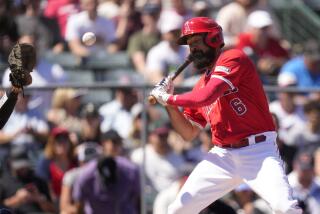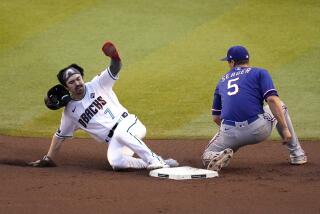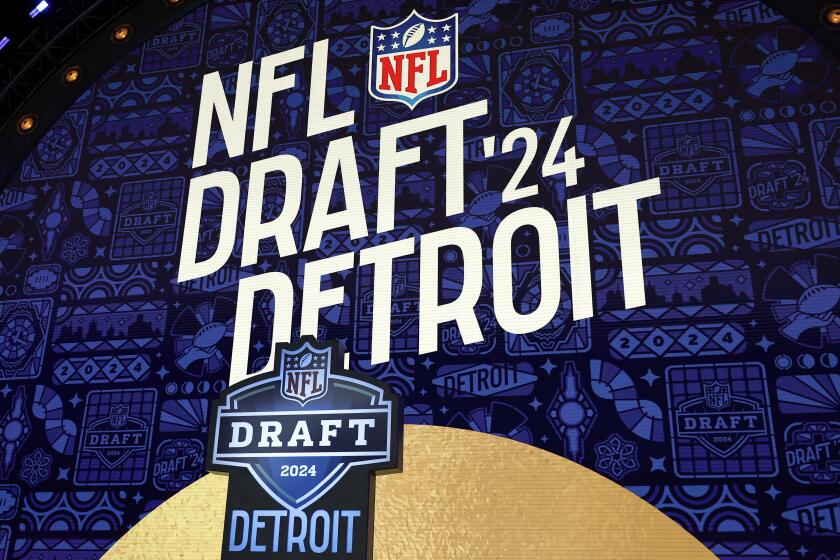Angels’ Mike Scioscia is keeper of legacy as MLB chips at block rule

TEMPE, Ariz. — The keepers of the gate for the Angels, the catching crew, play for the ultimate keeper of the gate.
All it takes to establish Manager Mike Scioscia is just that are Internet replays of his home-plate blocking when he was a catcher for the Dodgers. His collisions are legendary. So are his survivals.
In one, Scioscia holds onto the ball for the out despite a huge hit. No less than Vin Scully intones, “I have never in my life seen a catcher block the plate like Mike Scioscia.”
Scioscia was asked here the other day whether he ever had concussions.
“Sure, I had some,” he said. “Jack Clark [of the Cardinals] knocked me out in 1985.”
That triggered the famous follow-up Scioscia quote. Asked by a reporter whether he had left the game, he said, “I left the world for about three minutes.”
Scioscia somehow held onto the ball and Clark was called out. That feeds the legend of macho catchers. It also builds expectations.
The Angels’ main catching crew consists of probable starter Chris Iannetta and backups Hank Conger and John Hester. Even as baseball has joined other sports in attempting to reduce injuries and has begun to tinker with rules on what is acceptable in home-plate collisions, these three are well aware of the legacy of their position.
That legacy includes Ray Fosse, taking a shot from Pete Rose in the 1970 All-Star Game; Greg Olson of the Braves, effectively having his career ended when Ken Caminiti of the Astros barreled him over and broke his leg in 1992; and more recently, Scott Cousins of the Marlins destroying Buster Posey with a crunching blow that ended Posey’s 2011 Giants season in May with a broken leg and torn ligaments.
The replay of Posey, clawing at the dust in pain, is chilling.
That incident was probably the trigger to this spring’s rules change. There are shades of gray that still exist and it will be an interesting season of umpire interpretations.
“The rule seems to have evolved over the last three weeks,” Iannetta says. “I feel better about it now than when I first heard the changes.”
One explanation of the rule shift is that it attempts to legislate against a catcher getting blindsided. To that end, it says a runner may not deviate his path (go headhunting); that a runner must direct his effort to touching the plate, not creating contact with the catcher; that the runner can’t lead with his shoulder or arms, and that the catcher must have the ball in hand to block the plate, unless the throw takes him to that spot.
If that seems a lot to sort out on a bang-bang play, start sympathizing with the umpires now.
When the recent rule change was announced, opinionated typists filled chat sites. Many saw the attempt at injury prevention as laudable. Others referred to Major League Baseball as “wusses.”
Welcome to the world of Iannetta, Conger and Hester.
“I’ve been pretty fortunate in my career,” Iannetta says, recalling shots he has taken recently from Justin Upton of the Braves and Adam Dunn of the White Sox, neither causing injury.
But he also recalled a hit he took his freshman year at North Carolina.
“It was an NCAA regional game,” Iannetta says. “We were playing South Carolina and Yaron Peters came in knees first on me. It bruised my thigh so bad I couldn’t play the rest of the tournament. I sure remember that.”
Conger says, “I never got absolutely bulldozed.”
But he remembers a teammate who did in 2007, in a Midwest League game. Conger’s Cedar Rapids Kernels were playing the Beloit Snappers and Jon Hodach was catching for the Kernels, when he was clobbered at home plate by Danny Santiestaban, now a major leaguer with the Royals.
“It was a bad one,” Conger says. “They were both down for awhile. I don’t think Hodach played much after that.”
That, indeed, was Hodach’s final pro season.
Conger says he took a shot on his jaw from an elbow, when his mask came up, in a spring training game a few years ago.
“The guy’s name is Mitchell,” Conger says. “I see him around, we even hang out a little. He always tells me, ‘Hey, man. My bad.’ ”
Hester grew up an Atlanta Braves fan and remembers Olson being carted off after talking the shot from Caminiti. “There was no intent to slide,” he says.
Hester, a Stanford grad, says that collisions are often the product of decent people caught up in the heat of the moment and doing something stupid. The Darin Erstad hit on Johnny Estrada in 2005 probably falls into that category. The Braves’ Estrada suffered from post-concussion syndrome for several years and the Angels’ Erstad was very public in his regrets.
“Somebody’s health is more important than a game,” he said.
Hester says he has been lucky, that his worst moment was jarring, but mostly a strange play. Brett Lawrie of the Blue Jays collided with him and hit him high, but Hester held on. Almost always in that scenario, the runner is called out. This time, Lawrie was called safe.
“I went to argue,” Hester says, “but Scioscia was right there.”
Hester says Scioscia told him afterward he had “shown us a lot today.”
To be clear, Scioscia is no advocate of mindless machismo on the part of his gate keepers. He has been dinged enough — maybe more than anybody — to know better. He thinks the new rules will gradually be sorted out and help.
“Blindside collisions are a thing of the past,” he says.
So, hopefully, are three-minute departures from the world.
More to Read
Get our high school sports newsletter
Prep Rally is devoted to the SoCal high school sports experience, bringing you scores, stories and a behind-the-scenes look at what makes prep sports so popular.
You may occasionally receive promotional content from the Los Angeles Times.







